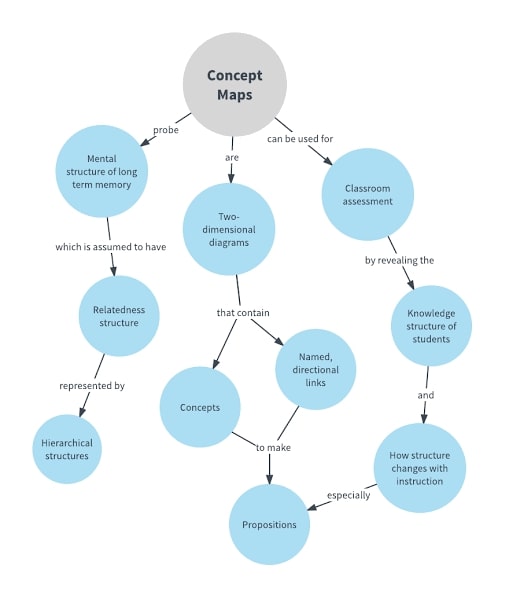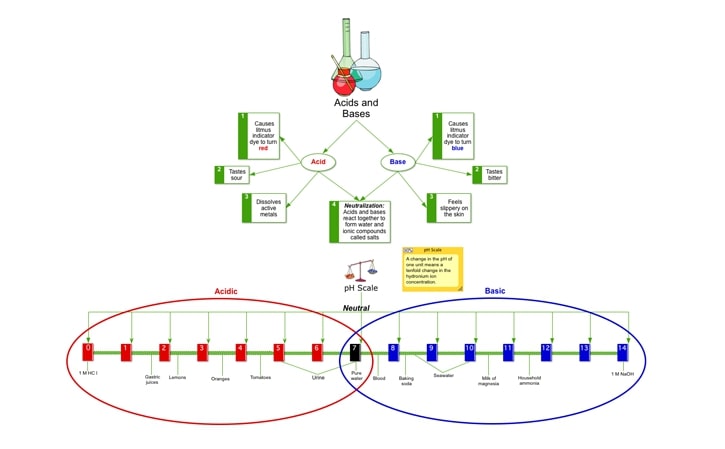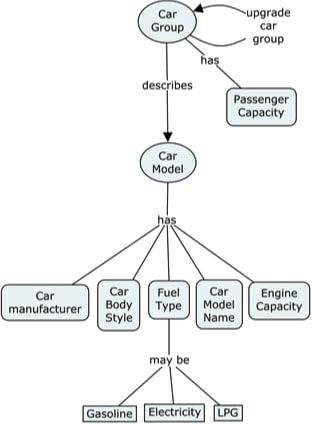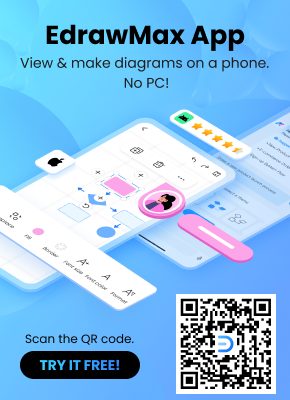What is A Concept Map with Examples
Create a Concept Map on Edraw.AI Online Free Free Download Free Download Free Download Free DownloadIn this article, we will learn everything there is to about concept maps, what they are, what use do they have, some real-life examples, and, most importantly, how to create one.
1. What is a Concept Map?
A concept map is a visualization tool for graphically representing knowledge or concepts. However, if you are looking for a definition to put in your project report, you may refer to the following viewpoint:
“A Concept Map is a graphical visualization tool for organizing as well as representing knowledge or concepts and is used to draw a relation between those concepts with their applicable ideas. The concepts are depicted as enclosed within circular or oval-shaped boxes and linked to one another with connecting lines; the phrases on the connecting lines show us the relation between two particular concepts.”
These concepts within circularly shaped boxes are called nodes in a concept map. These nodes get structured by maintaining the hierarchical order in which they are to be perceived and interpreted. The connecting lines are called arcs, and sometimes they have an arrowhead showing the flow of the map.

Image Source: gstatic.com
2. Key Elements of a Concept Map
Concept maps often referred to as conceptual diagrams may seem similar to other types of graphs. However, they have specific unique characteristics:
- Concepts
Concepts are the apparent patterns in any event or object that are designated by a label. They represent in the map as circular or oval shapes.
- Linking words/phrases
These are present on the lines connecting each idea to the next one. They describe the relationship between the two connected concepts. These phrases are as concise as possible, and typically they contain a verb. For example, cause, includes, etc.
- Hierarchical structure
It is the most critical element of a concept map. The most comprehensive and general concepts get placed towards the top with the more specific ones below, maintaining the pecking order. The way to read a concept map is from top to bottom, much like Japanese scriptures.
- Focus question
If a hierarchical structure is the most critical element, then the focus question is the necessary element. That is because the focus question defines the problem you want to address and solve with the concept map. It often serves as the reference point of the plan. Hierarchically a focus question remains at the very top of the map.
- Cross-links
In a concept map, it often happens that concepts from different fields and domains are related to each other, and to define or label this relation, you use a cross-link. This is the element that brings in the creativity in a concept map.
3. Concept Map Examples
-
Focus Question: Acids & Bases
The following Concept Map in science is used to visually represent the underlying concept of Acids and Bases, their characteristics, and the results of the neutralization reaction. Find more concept map examples.

Image Source: inspiration.com
-
Focus Question: Car Group
The following concept map example describes a car group and all the related concepts. It shows what a car group has and describes the car models that include theories of the manufacturer, body type, etc. this can be a valid map for starting your car dealership.

Image Source: graphdatamodeling.com
-
Focus Question: Parts of Speech
The following concept map can be used to teach students about the different parts of speech. For a better understanding of the key elements are highlighted in red.

Image Source: gstatic.com
4. Why is Concept Mapping Important?
The human brain processes visuals (photos, slides, etc.) much faster than it does so with texts, about 60,000 times faster. The theory of concept mapping revolves very much around this fact. As such, this tool is designed to help users visualize relationships between various concepts and improves their capability of comprehending complex subjects. It helps to form a mental connection, which in turn allows for better understanding and preservation of knowledge and information.
Although concept mapping generally applies to academia, it can be useful in various other fields as well. We will see them later on. There are a variety of benefits that one can extract out of it:
- Helps users to understand concepts more clearly by enabling them to visualize the said concept(s);
- Though it synthesis of information with the integration of new ideas to existing older ones, it allows a user to grasp the big picture;
- Helps to encourage brainstorming and sophisticated thinking in students;
- Helps students to discover new concepts and forge their connections;
- Helps users to communicate more clearly and easily regarding complex ideas.
5. Concept Map Use Cases
Concept Maps are easy to make, and you can use them for any area of content. The purpose of making a concept map is to depict information and concepts in an orderly visual representation. Not only it makes it easy to understand complex information, but your brain can also remember it for a longer time compared to plain text. It is also the reason why concept maps gained popularity in various fields such as research and business.
Concept Map for Nursing: Concept mapping is a helpful tool for nursing. You can easily represent detailed and specific information using concept maps. It helps you define patient issues, and you can group patients with similar issues for data comparison. After defining the issue, you can organize the patient's assessment results, and you can use the results to diagnose the issue and select the procedure to deal with it.
Concept Map for Education: Concept maps were first introduced as an educational tool to help students better understand various concepts and visually represent their research. Concept maps are commonly used for educating students by increasing meaningful learning. Teachers can share a concept map with important information about any topic. It tells students about the areas where they need improvements. Concept mapping helps students develop critical thinking and problem-solving skills.
Concept Map for Business: Concept mapping is beneficial for businesses because it helps create a concept model. A concept model depicts both business requirements and solutions. You can use concept maps for marketing as well. It helps with brainstorming and developing new business strategies. You can also use it to draft documents and make presentations for your team.
6. Concept Map vs. Mind Map
Concept Map and Mind Map might sound similar, but both of these are primarily different. It is widespread to take one as the other. Both of these maps visually represent ideas and information but the way they both work is different. Here are some of the key features that will help you tell both of these apart.
Concept Map
The general concept behind the topic is at the top of the map. Based on the hierarchy, we start looking at the concept from its basic idea and then move towards related concepts. It is a network of concepts that represent interconnected ideas and their relationship that makes it more logical.
Modifying a concept map gets more complex when you add more than twenty nodes, but you can easily verify it because every idea or concept connects to others. It represents tacit knowledge and depicts many concepts cross-linked with other concepts.

Mind MAP
The basic idea behind the topic is commonly placed at the center of the map. Every node comes out from the center of the map, and every idea is wholly based on internal information. Organized information links to the basic idea to form a tree chart. You can add lots of information and add many nodes that make mind maps more flexible.
Modifying a mind map is easy even when you represent lots of information, and your map contains many nodes, but it also means that you can't verify it. It can only represent nodes with a simple relationship that makes it easy for brainstorming and making quick notes.

7. Limitations of Concept Map
Although concepts maps are very beneficial to users, especially students, it does have some limitations or flaws:
- Compared to a multiple-choice questionnaire, a concept map becomes harder to evaluate for the instructors;
- Sometimes all the concept maps look similar which again makes it hard for the instructor to assess them;
- Grad-students generally refrain from using concept maps as they seem rather dull after numerous sessions of solving differential equations and SHM equations;
8. Evolution of the Concept Mapping Theory
The origins of the Concept Mapping Theory date back to Dr. Joseph Novak’s Theory of learning in the 1970s. He and his researchers team from Cornell University were trying to understand and describe the conceptual understandings of children.
They were studying Piaget’s theories of cognitive operational stages at the time. Psychologist Jean Piaget postulated that children below the age of eleven could not comprehend abstract concepts like, for example, the nature of matter. Furthermore, Dr. Novak also got inspired by the works of David Ausubel, a well-known proponent of Piaget’s theories. Based on these backgrounds, Dr. Novak decided to work on a new project where they would observe minute changes in the behavior of children while learning new ideas.
He took Ausubel’s work as a basis for his research project.
According to David Ausubel: “The single most important factor in learning is what the learner already knows; to establish that fact and teach the learner accordingly is the best path to follow.”
It became the cornerstone for his “Theory of Learning” and the concept map. Thus from 1972 onwards, the concept map has become the most widely used tool and is used by specialists across many fields from science & education to business & healthcare.
9. How to create the ideal Concept Map with EdrawMax Online?
EdrawMax Online is the best tool for creating concept maps. It is compatible with both Windows, macOS and Linux with numerous inbuilt templates to help you create concept mapping in science and other fields. Here you can find detailed steps of how to create a concept map.
Let us see how you can create the ideal concept map with EdrawMax Online:
Step 1: As the first step, open the EdrawMax Online to sign up and login.
Step 2: Now, select the ‘Concept Map’ template, and a new drawing window will open.
Step 3: From the ‘Concept Map Shapes’ library to the left of the canvas, drag and drop the shapes you want and double click on the forms to label them.
Step 4: Then, use the line tool to create the connecting lines. Click at any connecting end of the shape and drag till the connecting point of the next.
Step 5: Keep doing this till all the concept shapes edit and connect as per the project.
Step 6: Finally, save your project on the Google cloud service.
10. Concept Map FAQ
What is a nursing concept map?
A nursing concept map is a visual representation of patient issues, diagnosis, and procedure. It is a graphic tool that can integrate inputs from various experts on the same issue. It makes it easy to diagnose the cause of a patient's issue after they define it. Doctors can devise various strategies with concept mapping.
What is a concept map in education?
Students use concept maps to create a graphical representation of various topics and their research. A concept map comes in various types. Students can use it as a Venn diagram, flowchart, or T-chart to depict information and concepts. It makes learning easy and creative.
What is a photosynthesis concept map?
A photosynthesis concept map makes it easier for students to understand the process of photosynthesis in plants. It contains detailed information related to every step in a hierarchal manner. It helps students remember which process takes place first and what reactions are going on behind it.





